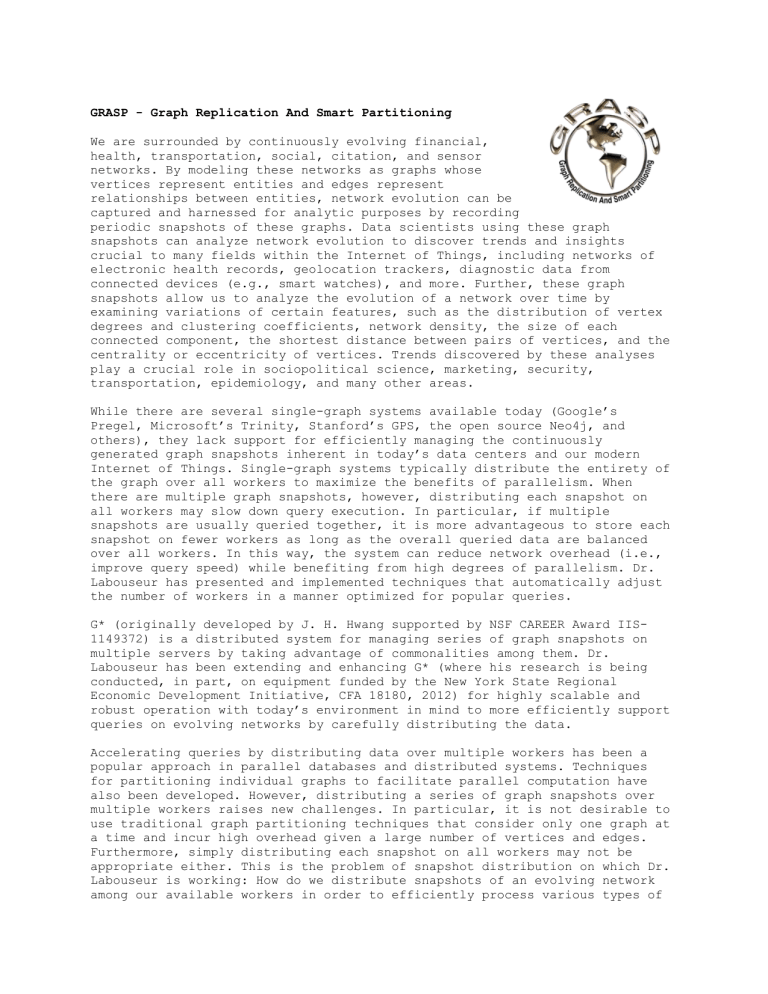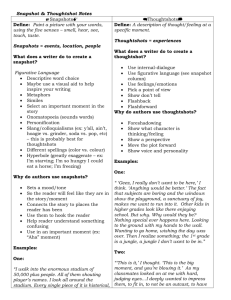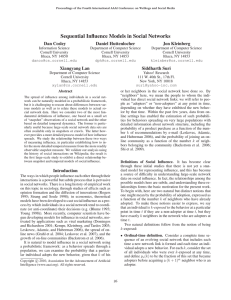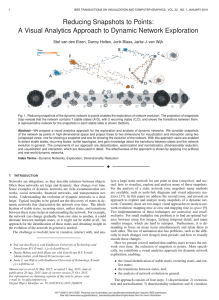Document 10960755

GRASP - Graph Replication And Smart Partitioning
We are surrounded by continuously evolving financial, health, transportation, social, citation, and sensor networks. By modeling these networks as graphs whose vertices represent entities and edges represent relationships between entities, network evolution can be captured and harnessed for analytic purposes by recording periodic snapshots of these graphs. Data scientists using these graph snapshots can analyze network evolution to discover trends and insights crucial to many fields within the Internet of Things, including networks of electronic health records, geolocation trackers, diagnostic data from connected devices (e.g., smart watches), and more. Further, these graph snapshots allow us to analyze the evolution of a network over time by examining variations of certain features, such as the distribution of vertex degrees and clustering coefficients, network density, the size of each connected component, the shortest distance between pairs of vertices, and the centrality or eccentricity of vertices. Trends discovered by these analyses play a crucial role in sociopolitical science, marketing, security, transportation, epidemiology, and many other areas.
While there are several single-graph systems available today (Google’s
Pregel, Microsoft’s Trinity, Stanford’s GPS, the open source Neo4j, and others), they lack support for efficiently managing the continuously generated graph snapshots inherent in today’s data centers and our modern
Internet of Things. Single-graph systems typically distribute the entirety of the graph over all workers to maximize the benefits of parallelism. When there are multiple graph snapshots, however, distributing each snapshot on all workers may slow down query execution. In particular, if multiple snapshots are usually queried together, it is more advantageous to store each snapshot on fewer workers as long as the overall queried data are balanced over all workers. In this way, the system can reduce network overhead (i.e., improve query speed) while benefiting from high degrees of parallelism. Dr.
Labouseur has presented and implemented techniques that automatically adjust the number of workers in a manner optimized for popular queries.
G* (originally developed by J. H. Hwang supported by NSF CAREER Award IIS-
1149372) is a distributed system for managing series of graph snapshots on multiple servers by taking advantage of commonalities among them. Dr.
Labouseur has been extending and enhancing G* (where his research is being conducted, in part, on equipment funded by the New York State Regional
Economic Development Initiative, CFA 18180, 2012) for highly scalable and robust operation with today’s environment in mind to more efficiently support queries on evolving networks by carefully distributing the data.
Accelerating queries by distributing data over multiple workers has been a popular approach in parallel databases and distributed systems. Techniques for partitioning individual graphs to facilitate parallel computation have also been developed. However, distributing a series of graph snapshots over multiple workers raises new challenges. In particular, it is not desirable to use traditional graph partitioning techniques that consider only one graph at a time and incur high overhead given a large number of vertices and edges.
Furthermore, simply distributing each snapshot on all workers may not be appropriate either. This is the problem of snapshot distribution on which Dr.
Labouseur is working: How do we distribute snapshots of an evolving network among our available workers in order to efficiently process various types of
queries?
As implied above, there are vast differences in execution time depending on the distribution configurations and the number of snapshots queried together.
Replication gives us, in addition to enhanced system reliability, the opportunity to utilize as many distribution configurations as there are replicas. In Dr. Labouseur’s current work, G* constructs r replicas for each snapshot to tolerate up to r − 1 simultaneous worker failures. This technique classifies queries into r categories and optimizes the distribution of each replica for one of the query categories.
Selected Publications:
A. Labouseur , J. Birnbaum, J. Olsen, Paul W., S. Spillane, J. Vijayan, J.-H.
Hwang, and W.-S. Han, “The G* graph database: efficiently managing large distributed dynamic graphs,” Distributed and Parallel Databases, vol. 33, no.
4, pp. 479–514, 2015.
A. G. Labouseur , P. W. Olsen, K. Park, and J. Hwang, “A demonstration of query-oriented distribution and replication techniques for dynamic graph data,” in 23rd International World Wide Web Conference, WWW ’14, Seoul,
Republic of Korea, April 7-11, 2014, Companion Volume, 2014, pp. 127–130.
S. R. Spillane, J. Birnbaum, D. Bokser, D. Kemp, A. Labouseur , P. W. Olsen
Jr., J. Vijayan, and J.-H. Hwang, “A Demonstration of the G* Graph Database
System,” in ICDE, 2013, pp. 1356–1359.
A. G. Labouseur , P. W. Olsen, and J. Hwang, “Scalable and robust management of dynamic graph data,” in Proceedings of the First International Workshop on
Big Dynamic Distributed Data, Riva del Garda, Italy, August 30, 2013, 2013, pp. 43–48.







